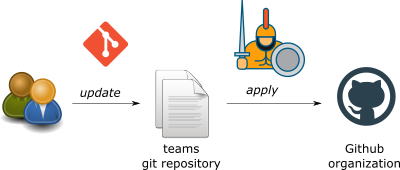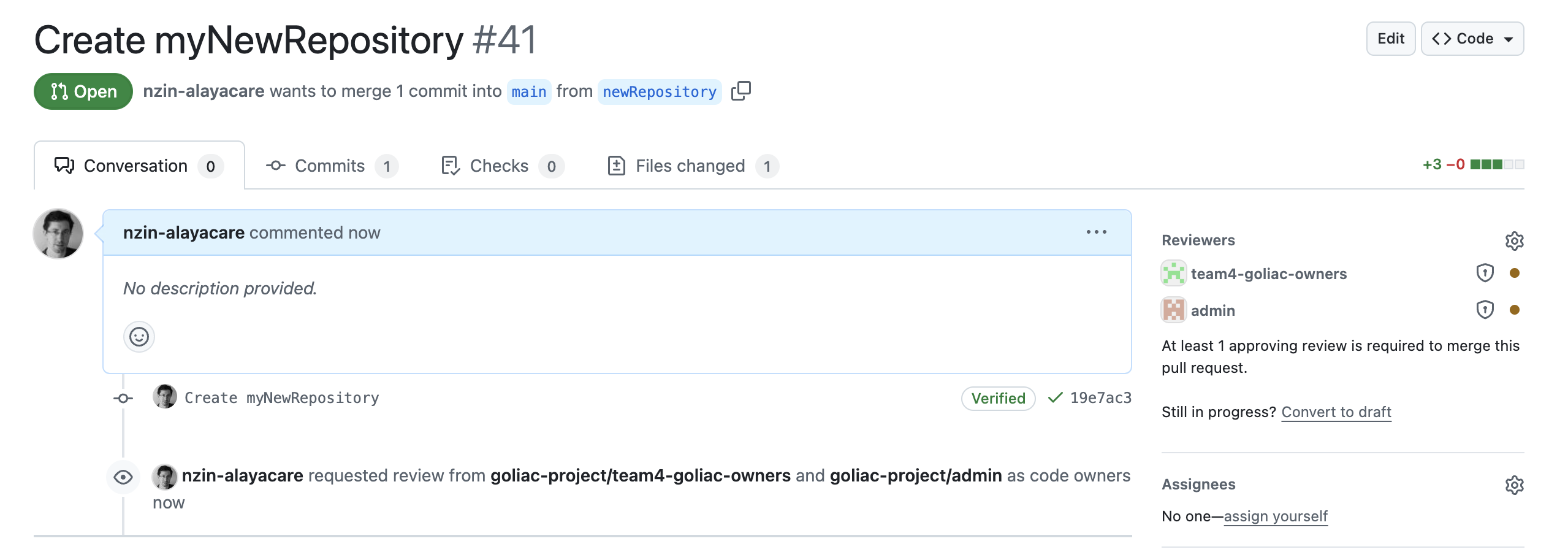What is Goliac
Goliac is a tool to manage your Github organization in a GitOps way, a bit like ArgoCD, (or Terraform ) but for Github organization.
It allows you to
- define your Github organization structure (teams, users, repositories) into a git repository, and to apply this structure to your Github organization.
- enforce security rules (like Github Rulesets) across your Github organization
- allow your developers to manage their team and their repositories (and only them) autonomously
You will get the most of Goliac if you are on an Enterprise plan, or on prem (especially to be able to use Github Ruleset), and it runs well for organization with ~ 1000-2000 repos, ~ 500-1000 users, ~ 300-500 teams or below. It should works well above these numbers, but you may need to adapt the way you use it (because it may need to do a lot of API calls to Github).
Goliac is a free opensource project, that you can install on your own infrastructure, and that is designed to be run easily into a kubernetes environment.
Why Goliac
Goliac can improve your Github organization management in several ways:
- security
- developer friendly
- cost
Security
For example, if you need to be SOC 2 compliant, you are supposed to
- have controls around change management, development lifecycle, access control, and review of changes to systems.
- but do you manage to enforce and reduce the number of people who are Gitub admins?
Developer friendly
How do you ensure your IT team creates/give access to the proper repositories to individuals and teams often without any context?
Cost
You may achieve similar result than Goliac with tools like terraform (even if not as flexible than Goliac), but Terraform Cloud costs can ramp up quickly.
How it works

Goliac use a GitOps approach:
- you define into one Github repository (usually called
goliac-teams), through yaml files, organized into a file hierarchy, the state you want your Github organization to be. You define- your security rules
- your users (or you import/link them from another external source)
- your teams
- the repositories owned by each teams
- when Goliac runs, it will apply these state to your Github organization (and enforce it)
- each change you want to bring is done via a Github Pull Request, that needs to be reviewed and validated, and can be auditing via the Git commit history
- each team can change part of the
goliac-teamsstructure they own (a sub directory)
Opinionated but flexible
Goliac is opinionated in the way it works, but it is also flexible:
- you import your users (manually or via an external source, like Github SAML integration)
- you group them into teams (see below)
- you define repository and give them a team owner (and only one)
- other team can be "invited" to have read or read-write access to repos (owned by a specific team)

On the disk it translate to a hierarchy of yaml files like:
goliac-teams
├── teams
│ ├── teamA
│ │ ├── team.yaml <- the definition of team1
│ │ ├── repo1.yaml
│ │ └── repo2.yaml
│ └── teamB
│ ├── team.yaml <- the definition of team2
│ └── repo3.yamlwhere a team.yaml looks like
apiVersion: v1
kind: Team
name: teamA
spec:
owners:
- user1@alayacare.com
- user2@alayacare.comand a repo.yaml looks like
apiVersion: v1
kind: Repository
name: repo1Giving access to a repository
You can give access to a repository to a team by editing a repository yaml file.

For example to give read access to teamA to repo3, you can edit repo3.yaml like:
apiVersion: v1
kind: Repository
name: repo3
spec:
readers:
- teamAThe nice thing is that:
- you can do it editing and submitting this change via a Pull Request (GitOps)
- IT do not need to be in the loop, team B can approve itself the PR (with the magic of CODEOWNERS file)
Creating new repositories
You can create a new repository by creating a new yaml file into your team directory, via a Pull Request, and ask a colleague for a review.

Note: the colleague must be in the team that owns the repository, and in the owners section of the team. Usually owners are PM, or tech leads.
Enforcing security rules
Goliac allows you to enforce security rules across your Github organization, via Github Rulesets. You can define global rules that will be applied to all repositories, or to a subset of repositories.
To do so, you can add rulesets into the main goliac.yaml file, and add some files into the rulesets directory:
goliac-teams
├── goliac.yaml
├── rulesets
│ └── default.yaml
├── teams
│ ├── teamA
│ │ ├── team.yaml <- the definition of team1
│ │ ├── repo1.yaml
│ │ └── repo2.yaml
│ └── teamB
│ ├── team.yaml <- the definition of team2
│ └── repo3.yamlSecurity friendly
Goliac allows your company to pass security compliance audit by:
- defining global rules (based on Github Rulesets if you are on Github Enterprise plan)
- allowing users to manage their team and the repositories they own (and only them)
- bringing auditing of who has done what in 2 places:
- via a git history of the
goliac-teamsrepository - via logs of Goliac service (but you need to have a good log management system in place)
- via a git history of the
- via a GitOps approach: i.e. via a clear directory structure stored into a git repository
Developer friendly
Once a team of developers has been created, the team can
- manage their resources (i.e. their team's member and their repositories defintion) autonomously (and so without having to rely on your IT departement each time a team needs a change)
- via simple yaml files. You dont need to learn a new specific definition langage.
- but restricted by global policies defined previously by the security team. For example you can specifiy a organization-wide policy asking for peer-review across all Github repositories, before any Pull Request being merged. Or you can ask a specific CI test to pass for all Github repositories, or a specific subset of Github repositoties
Cost
Goliac is a free opensource project. You can install it on your own infrastructure, and it is designed to be run easily into a kubernetes environment.
A comparable solution is to use Terraform (and a git repository) to achieve almost the same result, except that
- if you are using Terraform Cloud, you will have to pay for each resource you manage
- with terraform, you still need to centrally managed all operations via your IT team, which can be a bottleneck, and also less flexible
Why not using other tools?
There are several existing tools that can help you define automatically your Github organization
Why not using terraform/another tool
You can use Terraform (and a git repository) to achieve almost the same result, except that with terraform, you still need to centrally managed all operations via your IT team.
Goliac allows you to provide a self-served tool to all your employees
Why not using Github integrations
Github itself allows you different integrations (see https://github.com/ORG/goliac-project/settings/security), in particular
- SSO users integration (SAML)
- and teams integration (Azure Active Directory and Okta)
If Github integration fits your needs, go for it. But if you want some flexibility (creating teams independently than the company organization, not having to rely on the IT departement each time you want to create a repository), Goliac may be more flexible to use.
Requirements
To use the full capabilities of Goliac, through the Github Rulesets features you need
- either to be on Github cloud on the Enteprise plan
- or use GHES (Github Enterprise Server) 3.11
Cost and installation
- Goliac is a free opensource project.
- currently Goliac manages 1 Github organization per instance
- The installation is relatively easy:
- either you install a standalone application (Goliac app comes as a single binary)
- or you deploy Goliac docker image (via docker-compose or in kubernetes). You can build yourself the docker image or use pre-built images (https://github.com/goliac-project/goliac/pkgs/container/goliac).
- you need to create a definition of what Goliac manages: aka the goliac "teams" repository. With it you can define and managed either partially or totally your Github organization
- the definition (and the maintenance) of your Github organization is done via simple yaml file, and dont requires special skills or langage know-how
